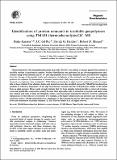Por favor, use este identificador para citar o enlazar a este item:
http://hdl.handle.net/10261/39869COMPARTIR / EXPORTAR:
 SHARE
BASE SHARE
BASE
|
|
| Visualizar otros formatos: MARC | Dublin Core | RDF | ORE | MODS | METS | DIDL | DATACITE | |

| Título: | Identification of protein remnants in insoluble geopolymers using TMAH thermochemolysis/GC-MS |
Autor: | Knicker, Heike CSIC ORCID ; Río Andrade, José Carlos del CSIC ORCID ; Hatcher, Patrick G.; Minard, Robert D. | Palabras clave: | TMAH/thermochemolysis Refractory organic nitrogen GC/MS Humin Algae Peptide Amino acid Protein |
Fecha de publicación: | 2001 | Editor: | Elsevier | Citación: | Organic Geochemistry 32(3): 397-409 (2001) | Resumen: | Thermochemolysis with tetramethylammonium hydroxide (TMAH) was utilized to analyze peptide-like material in insoluble residues of geochemical samples. Product identification was performed by gas chromatography/mass spectrometry using bovine albumin and di-, tri- and oligo-peptides. Most of the identified amino acid derivatives originate from the cleavage of the peptide bonds and subsequent methylation of the carboxylic and the amino groups. Some products are explained by deamination of aromatic amino acids. Only two products were identified that experienced chemical rearrangement after methylation. TMAH/thermochemolysis of algal material resulted in products comparable to those obtained from albumin. Amino acid derivatives were also identified among the TMAH/thermochemolysis products of refractory biopolymer of the alga Scenedesmus communis and the HCl-hydrolysis residue of the humin from an algal sapropel. These results strongly indicate that for those samples, hydrolysis fails to extract all proteinaceous and peptide-like components, possibly because these approaches rely on extraction of peptides and amino acids into solution and some of these are entrapped within a non-extractable hydrophobic network. However, alternative explanations for this behavior are possible. For example, at the higher temperatures and pressures and strongly basic conditions used in TMAH themochemolysis, penetration of this hydrophobic barrier takes place thus allowing breakdown and methylation of protein remnants. | Descripción: | 13 páginas, 5 figuras, 2 tablas. | URI: | http://hdl.handle.net/10261/39869 | ISSN: | 0146-6380 |
| Aparece en las colecciones: | (IRNAS) Artículos |
Ficheros en este ítem:
| Fichero | Descripción | Tamaño | Formato | |
|---|---|---|---|---|
| Identification_protein.pdf | 280,21 kB | Adobe PDF |  Visualizar/Abrir |
CORE Recommender
Page view(s)
455
checked on 23-abr-2024
Download(s)
436
checked on 23-abr-2024
Google ScholarTM
Check
NOTA: Los ítems de Digital.CSIC están protegidos por copyright, con todos los derechos reservados, a menos que se indique lo contrario.
